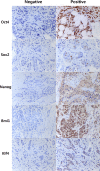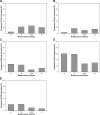Expression of embryonal stem cell transcription factors in breast cancer: Oct4 as an indicator for poor clinical outcome and tamoxifen resistance
- PMID: 28422735
- PMCID: PMC5482656
- DOI: 10.18632/oncotarget.16750
Expression of embryonal stem cell transcription factors in breast cancer: Oct4 as an indicator for poor clinical outcome and tamoxifen resistance
Abstract
The transcription factors of embryonic stem cells, such as Oct4, Sox2, Nanog, Bmi1, and Klf4, are known to be associated with stemness, epithelial-mesenchymal transition and aggressive tumor behavior. This study was designed to evaluate the clinicopathological significance of their expression in breast cancer. Immunohistochemistry for Oct4, Sox2, Nanog, Bmi1, and Klf4 was performed in 319 cases of invasive breast cancer. The relationship between the expression of these markers and clinicopathologic features of the tumors, including breast cancer stem cell phenotype and epithelial-mesenchymal transition marker expression, and their prognostic value in breast cancer, were analyzed. Expression of Oct4 and Sox2 was commonly associated with high histologic grade and high Ki-67 index in the whole group and in the hormone receptor-positive subgroup. On the other hand, expression of Nanog, Bmi1, and Klf4 was inversely correlated with aggressive features of the breast cancer. Oct4 expression was associated with ALDH1 expression but not with epithelial-mesenchymal transition marker expression. In survival analysis, Oct4 expression was independently associated with poor prognosis in the whole group and in the hormone receptor-positive subgroup, but not in hormone receptor-negative subgroup. Particularly, Oct4 expression was associated with poor clinical outcome in patients with hormone receptor-positive breast cancer treated with tamoxifen. Our results indicate that Oct4 expression is associated with aggressive features, ALDH1 expression, tamoxifen resistance and poor clinical outcomes in hormone receptor-positive breast cancer, and thus may be useful as a predictive and prognostic marker in this subgroup of breast cancer.
Keywords: Oct4; breast cancer; cancer stem cell; prognosis; tamoxifen resistance.
Conflict of interest statement
All authors declare no conflicts of interests.
Figures



Similar articles
-
IL-33 facilitates endocrine resistance of breast cancer by inducing cancer stem cell properties.Biochem Biophys Res Commun. 2017 Apr 8;485(3):643-650. doi: 10.1016/j.bbrc.2017.02.080. Epub 2017 Feb 17. Biochem Biophys Res Commun. 2017. PMID: 28216163
-
Different Effects of BORIS/CTCFL on Stemness Gene Expression, Sphere Formation and Cell Survival in Epithelial Cancer Stem Cells.PLoS One. 2015 Jul 17;10(7):e0132977. doi: 10.1371/journal.pone.0132977. eCollection 2015. PLoS One. 2015. PMID: 26185996 Free PMC article.
-
Acquisition of epithelial-mesenchymal transition phenotype in the tamoxifen-resistant breast cancer cell: a new role for G protein-coupled estrogen receptor in mediating tamoxifen resistance through cancer-associated fibroblast-derived fibronectin and β1-integrin signaling pathway in tumor cells.Breast Cancer Res. 2015 May 21;17(1):69. doi: 10.1186/s13058-015-0579-y. Breast Cancer Res. 2015. PMID: 25990368 Free PMC article.
-
Yin Yang 1 is associated with cancer stem cell transcription factors (SOX2, OCT4, BMI1) and clinical implication.J Exp Clin Cancer Res. 2016 May 25;35:84. doi: 10.1186/s13046-016-0359-2. J Exp Clin Cancer Res. 2016. PMID: 27225481 Free PMC article. Review.
-
Crosstalks between Raf-kinase inhibitor protein and cancer stem cell transcription factors (Oct4, KLF4, Sox2, Nanog).Tumour Biol. 2017 Apr;39(4):1010428317692253. doi: 10.1177/1010428317692253. Tumour Biol. 2017. PMID: 28378634 Review.
Cited by
-
The Clinical and Molecular Characteristics of Sex-Determining Region Y-Box 2 and its Prognostic Value in Breast Cancer: A Systematic Meta-Analysis.Breast Care (Basel). 2021 Feb;16(1):16-26. doi: 10.1159/000505806. Epub 2020 Mar 26. Breast Care (Basel). 2021. PMID: 33716628 Free PMC article. Review.
-
LncRNAs and microRNAs as Essential Regulators of Stemness in Breast Cancer Stem Cells.Biomolecules. 2021 Mar 3;11(3):380. doi: 10.3390/biom11030380. Biomolecules. 2021. PMID: 33802575 Free PMC article. Review.
-
Simulated microgravity increases polyploid giant cancer cells and nuclear localization of YAP.Sci Rep. 2019 Jul 23;9(1):10684. doi: 10.1038/s41598-019-47116-5. Sci Rep. 2019. PMID: 31337825 Free PMC article.
-
OCT4, SOX2, and NANOG positive expression correlates with poor differentiation, advanced disease stages, and worse overall survival in HER2+ breast cancer patients.Onco Targets Ther. 2018 Nov 6;11:7873-7881. doi: 10.2147/OTT.S173522. eCollection 2018. Onco Targets Ther. 2018. PMID: 30464534 Free PMC article.
-
Endoplasmic reticulum stress confers 5-fluorouracil resistance in breast cancer cell via the GRP78/OCT4/lncRNA MIAT/AKT pathway.Am J Cancer Res. 2020 Mar 1;10(3):838-855. eCollection 2020. Am J Cancer Res. 2020. PMID: 32266094 Free PMC article.
References
-
- Bonnet D, Dick JE. Human acute myeloid leukemia is organized as a hierarchy that originates from a primitive hematopoietic cell. Nat Med. 1997;3:730–737. - PubMed
-
- Reya T, Morrison SJ, Clarke MF, Weissman IL. Stem cells, cancer, and cancer stem cells. Nature. 2001;414:105–111. - PubMed
-
- Visvader JE, Lindeman GJ. Cancer stem cells in solid tumours: accumulating evidence and unresolved questions. Nat Rev Cancer. 2008;8:755–768. - PubMed
-
- Ginestier C, Hur MH, Charafe-Jauffret E, Monville F, Dutcher J, Brown M, Jacquemier J, Viens P, Kleer CG, Liu S, Schott A, Hayes D, Birnbaum D, et al. ALDH1 is a marker of normal and malignant human mammary stem cells and a predictor of poor clinical outcome. Cell Stem Cell. 2007;1:555–567. - PMC - PubMed
MeSH terms
Substances
LinkOut - more resources
Full Text Sources
Other Literature Sources
Medical
Research Materials
Miscellaneous

